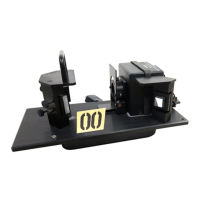AQ-00073-000, Rev. 7 23
ideal of perfect specular reflection.
If your sample approaches perfection, in either diffuse or specular reflectance distribution, your
scan data using the procedure above will be accurate. If your sample is not perfectly specular or
diffuse, you may decide simply to measure the sample as if it were either nearly specular or
Lambertian, accepting the fact that such measurements involve a higher-than-ordinary degree of
systematic uncertainty. Such an approach is more than adequate for many applications, espe-
cially those in which the emphasis is on repeatability rather than absolute accuracy of measure-
ment. Another alternative might be to scan the sample at the 8
°
geometry using the diffuse and
specular standards, and take the average reflectance of the two.
A more ambitious approach involves modeling the geometric reflectance distribution of the sam-
ple in question as an ideal "mixed" distribution, composed of two components, one of which is
perfectly specular, and the other, perfectly Lambertian. The sample is measured in both total
hemispherical (specular included) and diffuse (specular excluded) geometries, and the relative
magnitude of the two components is estimated from the results. For the RSA-PE-20 accessory,
the specular excluded geometry is at normal incidence where the specular component is rejected
from the sphere back through the transmittance port. Systematic errors involved in measuring a
partly-specular sample against a diffuse reference, or a partly-diffuse sample against a specular
reference, can then be corrected in accordance with this model. An example of such an approach
is presented below.
1. A first-surface mirror is measured with the instrument in the standard hemispheri-
cal configuration, first using a specular reference standard (M), then using a diffuse
reference standard (M'). The geometric correction factor
γ
is calculated as follows:
2. Next, the test sample is measured, using a diffuse reflectance standard, in both the
standard hemispherical, specular included, and diffuse, specular excluded, configu-
rations. These test sample results will be identified as R
SIN
and R
SEX
, respectively.
3. Given the assumption that the geometric reflectance distribution of the test sample
can be separated into two ideal components, one specular (S) and one perfectly
Lambertian (D), and further assuming that the diffuse component of the test sam-
ples above approximates a perfect Lambertian distribution, so that its reflectance
factor (
ρ
o
) is the same for both specular-included and specular-excluded geome-
tries, the following relations hold:
4. Rearranging the relation above, we get the following definitions for the specular
and diffuse components:
γ
MM'
⁄
=
Eq. 7
R
SEX
D
ρ
0
⁄
=
R
SIN
S' D+
()ρ
0
⁄
=
and
Eq. 8

